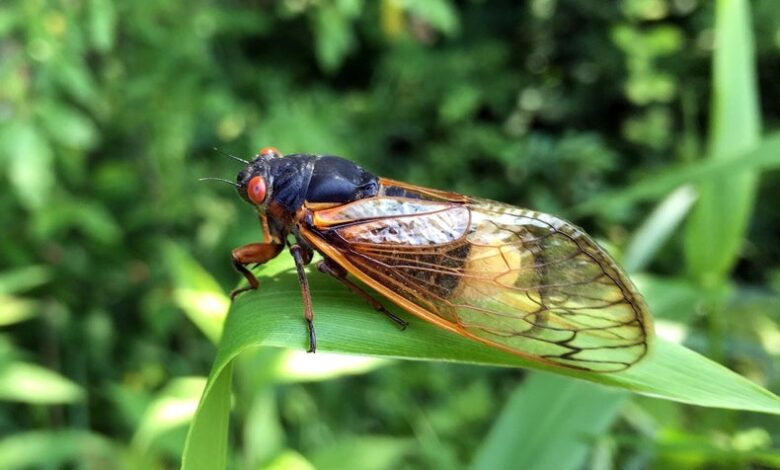How This Zombie Fungus Turns Cicadas into Horror-Movie Sex Bots

Matt Kasson, a forest pathologist and mycologist at West Virginia University, has spent the past week chasing cicadas across northern Virginia. Each night he has watched pale nymphs emerge from the earth like ghostly apparitions and then make their way into trees, where they will soon molt to become a winged adults.
Both the cicadas and Kasson have been waiting for this moment—but not for the same reason. After 17 years underground, billions of Brood X periodical cicadas, as the insects are known, are emerging into the light across the eastern U.S. this year to find mates and launch the next generation. Kasson, on the other hand, has come for an equally awe-inspiring yet very different facet of one of nature’s most epic life cycles: “the big fungal show,” as he puts it. It is one wild performance in which a parasitic fungus turns some of the insects into singled-minded sex machines—after causing their genitals to fall off. The phenomenon is well documented, but scientists such as Kasson are working to figure out how the freaky fungus hijacks its host.
An estimated 3,000 species of cicadas live around the world, and a diversity of parasitic fungi have evolved alongside them. Kasson studies one exceptionally peculiar species called Massospora cicadina. It only infects so-called periodical cicadas such as Brood X—those that emerge every 13 or 17 years.
M. cicadina’s spores have also patiently spent the past 17 years in the soil, awaiting the Brood X nymphs. The immature insects become infected when they come into contact with the spores on their way to the surface, and the fungus grows out of sight for the first seven to 10 days as its host molts into an adult.
After that deceptive period of quiet, however, the infection begins to manifest—with horrifying results. Males’ abdominal plates begin to slough off, revealing a chalky white plug made of fungal spores. The spores can come off when an insect walks or flies. But mostly, they spread through sex attempts.
Healthy male cicadas sing to attract females, which indicate their receptiveness to mating by flicking their wings. A female unfortunate enough to fall for an infected male’s siren song will not only fail to get her eggs fertilized (the male’s genitals have long since fallen off) but will also become infected herself, essentially making M. cicadina a sexually transmitted disease.
Infected females’ abdomen tends to remain more or less intact because they have stronger muscular tissue in place for laying eggs. But that does not mean females have it easy. If a male mates with an infected female, her fungus-ridden genitalia usually break off—and get carried away by the male. “Basically, the male has this permanent ornament attached to him with a legacy of deeds past done,” Kasson says. Some infected males also flick their wings like a female, attracting other hapless males that become infected when they attempt to mate.
Much of Kasson’s research entails figuring out how in the world the fungus compels cicadas to become sexual zombies for spreading its spores. In 2019 he and his colleagues reported in Fungal Ecology that one compound in particular, cathinone, seems to be key for turning M. cicadina–infected hosts into sexual automatons. Now, in Virginia, he is screening cicadas for fungal infections, looking for sample insects to study in the lab. “Also,” Kasson adds, “I have to admit I wasn’t going to miss the opportunity to just spend time with Brood X.”
Cathinone is a well-known, naturally occurring stimulant in the amphetamine family. Scientists had previously pinpointed it as an active ingredient in khat, a plant native to the Horn of Africa and the Arabian Peninsula, where people sometimes chew it for a buzz. Synthetic cathinone is also a key component in pharmaceuticals prescribed for attention deficit hyperactivity disorder and in illegal drugs called “bath salts.” “We aren’t seeing face-eating cicadas,” Kasson says, referring to a notorious 2012 Florida incident that media reports blamed on bath salts. “But we can learn something about how the fungus might be working from what these medicines are used for.”
Medications that contain synthetic cathinone, for example, can suppress appetite and increase the ability to focus. So it is possible the fungus alters host behavior to its advantage by making cicadas single-mindedly pursue mating rather than feeding or resting—thus spreading the spores to more mates.
Interestingly, Kasson and other researchers have also found evidence of psilocybin—the psychedelic ingredient in magic mushrooms—in another Massospora species that only infects annual cicadas in the western U.S. “Psilocybin and amphetamines are obviously two very different types of drugs, but we think these alkaloids could be having a bit of redundancy in the ability to suppress appetite, increase stamina and prolong wakefulness,” Kasson says.
He suspects that the presence of these compounds in Massospora species represents an example of convergent evolution, in which a feature independently evolves in different species to perform a similar function. Cathinone’s occurrence in khat plants, however, does raise one intriguing question: Could these plants contain hidden fungal partners that are actually the engineers behind the compounds? As Kasson points out, this would not be the first time that credit for a plant’s apparent psychoactive properties turned out to belong to a fungus: in 2004 scientists discovered that an LSD-like compound found in morning glory was not produced by the plant itself but by a fungus that lives inside it.
Kasson hopes to further investigate this and other questions in future studies. In particular, he would like to dose healthy cicadas directly with cathinone to see how it alters their behavior. He is also interested in looking at the dozen or so other Massospora species out there to see what interesting compounds they may hold—something that could even be useful for pharmaceutical drug discovery.
Speaking of drugs, however, Kasson emphasizes that people looking to get high should not turn to infected cicadas—something that he has been concerned to see discussed in online forums. It would take hundreds or even thousands of cicadas to produce a dose high enough to have an effect on humans, he says. And cicadas also contain more than 1,000 other compounds, some of them known toxins. “You’d have to eat an awful lot of cicadas to have some effect from the amphetamine that’s in there,” agrees Chris Simon, a phylogeneticist at the University of Connecticut. “You’d be sick long before you ate enough.”
That said, both Simon and Kasson say people should not worry much about pets or kids coming into contact with infected cicadas. For starters, it may be difficult to find them. Only about 5 percent of cicadas tend to be infected in the first place. And although Brood X consists of billions of insects, they are dispersed over a large geographical area. “I wouldn’t lick one myself,” Kasson says. “But if your animal eats one or two infected cicadas, that’s not going to be a problem.”
You can read the full article from the source HERE.
-
Sale!

Aurora: Tender Sex Doll
Original price was: $2,799.00.$2,599.00Current price is: $2,599.00. Buy Now -
Sale!

Dominique: Thick Sex Doll
Original price was: $2,499.00.$2,199.00Current price is: $2,199.00. Buy Now -
Sale!

Auburn: Red Head Sex Doll
Original price was: $2,199.00.$1,899.00Current price is: $1,899.00. Buy Now






